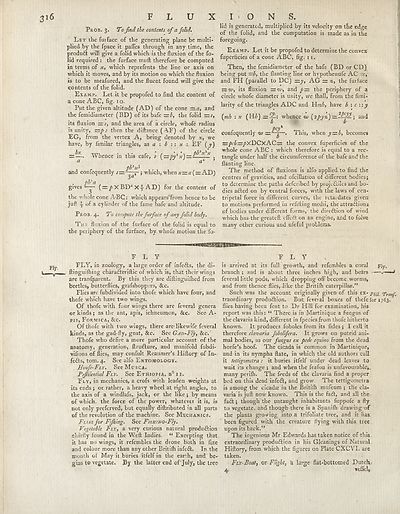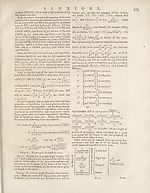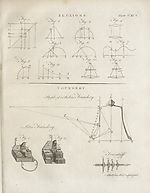Encyclopaedia Britannica > Volume 7, ETM-GOA
(342) Page 316 - FLY
Download files
Complete book:
Individual page:
Thumbnail gallery: Grid view | List view

FLUX
Pros. 3. To find the contents of a folid.
Let the furface of the generating plane be multi¬
plied by the fpace it pafles through in any time, the
produft will give a folid which is the fluxion of the fo¬
lid required : the furface muft therefore be computed
in terms of x, which reprefents the line or axis on
which it moves, and by its motion on which the fluxion
is to be meafured, and the fluent found will give the
contents of the folid.
Examp. Let it be propofed to find the content of
a cone ABC, fig. 10.
Put the given altitude (AD) of the cone =a, and
the femidiameter (BD) of its bafe —b, the folid
its fluxion rrj, and the area of a circle, whofe radius
is unity, =/: then the diftance ( AF) of the circle
EG, from the vertex A, being denoted by jv, we
have, by fimilar triangles, as a EF (y)
= —. Whence in this cafe, s (zzpy*x) — ^~.x .
pPx*
and confequently r=. 5- ; which, when *=:«(=AD)
. pbz(i
gives-y (= /> X BDa Xy AD) for the content of
the whole cone ABC: which appears*ffom hence to be
juft y of a cylinder of the fame bafe and altitude.
Prob. 4. To compute the furface of any folid body.
The fluxion of the furface of the folid is equal to
the periphery of the furface, by whofe motion the fo-
I O N S.
lid i^ generated, multiplied by its velocity on the edge
of the folid, and the computation is made as in the
foregoing.
Examp. Let it be propofed to determine the convex
fuperficies of a cone ABC, fig. 11.
Then, the femidiameter of the bafe (BD or CD)
being put —b, the flanting line or hypothenufe AC =c,'
and FH (parallel to DC) —y, AG = z, the furface
— w, its fluxion =w, and p=: the periphery of a
circle whofe diameter is unity, we ftrall, from the fimi-
larity of the triangles ADC and Hmh, have b :.c ::y
(mh : x (HZ>) —-y- whence w [2py%)—J£^-\ and
Pcy%
confequently w =—^—. This, when y — l, becomes
=^=/>XDCxAC= the convex fuperficies of the
whole cone ABC : which therefore is equal to a rec¬
tangle under half the circumference of the bafe and the
flanting line.
The method of fluxions is alfo applied to find the
centres of gravities, and ofcillation of different bodies;
to determine the paths defcribed by projectiles and bo¬
dies afted on by central forces, with the laws of cen¬
tripetal force in different curves, the retardates given
to motions performed in refilling medii, the attradlions.
of bodies under different forms, the direftion of wind
which has the greateft effefit on an engine, and to folve
many other curious and ufeful problems.
FLY
FLY
FLY, in zoology, a large order of infe&s, the di-
ftinguifhing charafteriftie of which is, that their wings
are tranfparent. By this they are diftinguifhed from
beetles, butterflies, grafshoppers, &c.
Flies are fubdivided into thofe which have four, and
thofe which have two wings.
Of thofe with four wings there are feveral genera
or kinds ; as the ant, apis, ichneumon, &c. See A-
pis, Formica, &c.
Of thofe with two wings, there are likewife feveral
kinds, as the gad-fly, gnat, &c. See GAD-Fly, &c.
Thofe who dfefire a more particular account of the
anatomy, generation, ftrufture, and manifold fubdi-
vifions of flies, may confult Reaumer’s Hiftory of In¬
fers, tom. 4. See alfo Entomology.
Houfe-Fir. SccMusca.
Pefiilential Per. See Ethiopia, n0n.
Fly, in mechanics, a crofs with leaden weights at
its ends; or rather, a heavy wheel at right angles, to
the axis of a windlafs, jack, or the like; by means
of which, the force of the power, whatever it is, is
not only preferved, but equally diftributed in all parts
of the revolution of the machine. See Mechanics.
Flies for Fijhing. See FisniNO-Fly.
Vegetable Fix, a very curious natural production
chiefly found in the Weft Indies. “ Excepting that:
it has no wings, it refembles the drone both in fize
and colour more than any other Britifh infeCt. In the
month of May it buries itfelf in the earth, and be¬
gins to vegetate. By the latter end of'July, the tree
is arrived at its full growth, and refembles a coral Fly.
branch ; and is about three inches high, and bears * J
feveral little pods, which dropping off become worms,
and from thence flies, .like the Britifh caterpillar.”
Such was the account originally given-of this ex- pm prarp
traordinary production. But feveral boxes of thefe for 1763.
flies having been fent to Dr Hill for examination, his
report was this: “ There is in Martinique a fungus of
the clavaria kind, different in fpecies from thofe hitherto
known. It produces foboles from its fides ; I call it
therefore clavaria fobolifera. It grows on putrid ani¬
mal bodies, as our fungus ex pede equino from the dead
horfe’s hoof. The cicada is common in Martinique,
and in its nympha ftate, in which the old authors call
it tettigometra: it buries itfelf under dead leaves to
wait its change ; and when the feafon is unfavourable,,
many perifh. The feeds of the clavaria find a proper
bed on this dead infeft, and grow The tettigometra
is among the cicadae in the Britifh mufeum ; the cla¬
varia is juft now known. This is the faft, and all the.
fad; though the untaught inhabitants fuppofe a fly
to vegetate, and though-there is a Spanifh drawing-of
the plants growing into a trifoliate tree, and it has.
been figured with the creature flying with this tree
upon its back.”
The ingenious Mr Edwards has taken.notice of this
extraordinary produ&ion in his Gleanings of Natural.
Hiftory, from which the figures on Plate CXCVI. are
taken.
Fir-Boat, or Flight, a large flat-bottomed Dutch.
4. veffelj
Pros. 3. To find the contents of a folid.
Let the furface of the generating plane be multi¬
plied by the fpace it pafles through in any time, the
produft will give a folid which is the fluxion of the fo¬
lid required : the furface muft therefore be computed
in terms of x, which reprefents the line or axis on
which it moves, and by its motion on which the fluxion
is to be meafured, and the fluent found will give the
contents of the folid.
Examp. Let it be propofed to find the content of
a cone ABC, fig. 10.
Put the given altitude (AD) of the cone =a, and
the femidiameter (BD) of its bafe —b, the folid
its fluxion rrj, and the area of a circle, whofe radius
is unity, =/: then the diftance ( AF) of the circle
EG, from the vertex A, being denoted by jv, we
have, by fimilar triangles, as a EF (y)
= —. Whence in this cafe, s (zzpy*x) — ^~.x .
pPx*
and confequently r=. 5- ; which, when *=:«(=AD)
. pbz(i
gives-y (= /> X BDa Xy AD) for the content of
the whole cone ABC: which appears*ffom hence to be
juft y of a cylinder of the fame bafe and altitude.
Prob. 4. To compute the furface of any folid body.
The fluxion of the furface of the folid is equal to
the periphery of the furface, by whofe motion the fo-
I O N S.
lid i^ generated, multiplied by its velocity on the edge
of the folid, and the computation is made as in the
foregoing.
Examp. Let it be propofed to determine the convex
fuperficies of a cone ABC, fig. 11.
Then, the femidiameter of the bafe (BD or CD)
being put —b, the flanting line or hypothenufe AC =c,'
and FH (parallel to DC) —y, AG = z, the furface
— w, its fluxion =w, and p=: the periphery of a
circle whofe diameter is unity, we ftrall, from the fimi-
larity of the triangles ADC and Hmh, have b :.c ::y
(mh : x (HZ>) —-y- whence w [2py%)—J£^-\ and
Pcy%
confequently w =—^—. This, when y — l, becomes
=^=/>XDCxAC= the convex fuperficies of the
whole cone ABC : which therefore is equal to a rec¬
tangle under half the circumference of the bafe and the
flanting line.
The method of fluxions is alfo applied to find the
centres of gravities, and ofcillation of different bodies;
to determine the paths defcribed by projectiles and bo¬
dies afted on by central forces, with the laws of cen¬
tripetal force in different curves, the retardates given
to motions performed in refilling medii, the attradlions.
of bodies under different forms, the direftion of wind
which has the greateft effefit on an engine, and to folve
many other curious and ufeful problems.
FLY
FLY
FLY, in zoology, a large order of infe&s, the di-
ftinguifhing charafteriftie of which is, that their wings
are tranfparent. By this they are diftinguifhed from
beetles, butterflies, grafshoppers, &c.
Flies are fubdivided into thofe which have four, and
thofe which have two wings.
Of thofe with four wings there are feveral genera
or kinds ; as the ant, apis, ichneumon, &c. See A-
pis, Formica, &c.
Of thofe with two wings, there are likewife feveral
kinds, as the gad-fly, gnat, &c. See GAD-Fly, &c.
Thofe who dfefire a more particular account of the
anatomy, generation, ftrufture, and manifold fubdi-
vifions of flies, may confult Reaumer’s Hiftory of In¬
fers, tom. 4. See alfo Entomology.
Houfe-Fir. SccMusca.
Pefiilential Per. See Ethiopia, n0n.
Fly, in mechanics, a crofs with leaden weights at
its ends; or rather, a heavy wheel at right angles, to
the axis of a windlafs, jack, or the like; by means
of which, the force of the power, whatever it is, is
not only preferved, but equally diftributed in all parts
of the revolution of the machine. See Mechanics.
Flies for Fijhing. See FisniNO-Fly.
Vegetable Fix, a very curious natural production
chiefly found in the Weft Indies. “ Excepting that:
it has no wings, it refembles the drone both in fize
and colour more than any other Britifh infeCt. In the
month of May it buries itfelf in the earth, and be¬
gins to vegetate. By the latter end of'July, the tree
is arrived at its full growth, and refembles a coral Fly.
branch ; and is about three inches high, and bears * J
feveral little pods, which dropping off become worms,
and from thence flies, .like the Britifh caterpillar.”
Such was the account originally given-of this ex- pm prarp
traordinary production. But feveral boxes of thefe for 1763.
flies having been fent to Dr Hill for examination, his
report was this: “ There is in Martinique a fungus of
the clavaria kind, different in fpecies from thofe hitherto
known. It produces foboles from its fides ; I call it
therefore clavaria fobolifera. It grows on putrid ani¬
mal bodies, as our fungus ex pede equino from the dead
horfe’s hoof. The cicada is common in Martinique,
and in its nympha ftate, in which the old authors call
it tettigometra: it buries itfelf under dead leaves to
wait its change ; and when the feafon is unfavourable,,
many perifh. The feeds of the clavaria find a proper
bed on this dead infeft, and grow The tettigometra
is among the cicadae in the Britifh mufeum ; the cla¬
varia is juft now known. This is the faft, and all the.
fad; though the untaught inhabitants fuppofe a fly
to vegetate, and though-there is a Spanifh drawing-of
the plants growing into a trifoliate tree, and it has.
been figured with the creature flying with this tree
upon its back.”
The ingenious Mr Edwards has taken.notice of this
extraordinary produ&ion in his Gleanings of Natural.
Hiftory, from which the figures on Plate CXCVI. are
taken.
Fir-Boat, or Flight, a large flat-bottomed Dutch.
4. veffelj
Set display mode to:
![]() Universal Viewer |
Universal Viewer | ![]() Mirador |
Large image | Transcription
Mirador |
Large image | Transcription
Images and transcriptions on this page, including medium image downloads, may be used under the Creative Commons Attribution 4.0 International Licence unless otherwise stated. ![]()
| Encyclopaedia Britannica > Encyclopaedia Britannica > Volume 7, ETM-GOA > (342) Page 316 - FLY |
|---|
| Permanent URL | https://digital.nls.uk/189125675 |
|---|
| Attribution and copyright: |
|
|---|
| Description | Ten editions of 'Encyclopaedia Britannica', issued from 1768-1903, in 231 volumes. Originally issued in 100 weekly parts (3 volumes) between 1768 and 1771 by publishers: Colin Macfarquhar and Andrew Bell (Edinburgh); editor: William Smellie: engraver: Andrew Bell. Expanded editions in the 19th century featured more volumes and contributions from leading experts in their fields. Managed and published in Edinburgh up to the 9th edition (25 volumes, from 1875-1889); the 10th edition (1902-1903) re-issued the 9th edition, with 11 supplementary volumes. |
|---|---|
| Additional NLS resources: |
|

